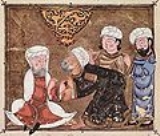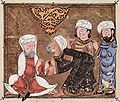
Ma'arrat al-Numan
Encyclopedia

Syria
Syria , officially the Syrian Arab Republic , is a country in Western Asia, bordering Lebanon and the Mediterranean Sea to the West, Turkey to the north, Iraq to the east, Jordan to the south, and Israel to the southwest....
with a population of about 90000 (year 2010). It is located at the highway between Aleppo
Aleppo
Aleppo is the largest city in Syria and the capital of Aleppo Governorate, the most populous Syrian governorate. With an official population of 2,301,570 , expanding to over 2.5 million in the metropolitan area, it is also one of the largest cities in the Levant...
and Hama
Hama
Hama is a city on the banks of the Orontes River in west-central Syria north of Damascus. It is the provincial capital of the Hama Governorate. Hama is the fourth-largest city in Syria—behind Aleppo, Damascus, and Homs—with a population of 696,863...
and near the Dead Cities
Dead Cities
-History:The Dead Cities are a group of 700 abandoned settlements in northwest Syria between Aleppo and Hama. They date back to before the fifth century CE and contain many remains of Christian Byzantine architecture...
of Bara
Bara, Syria
Bara also called Al-Bara is one of the former "Dead Cities" in northwestern Syria. It is located in the Jebel Riha, approx. 65 km north from Hama and approx. 80 km southwest from Aleppo....
and Serjilla
Serjilla
Serjilla is one of the best preserved of the Dead Cities in northwestern Syria. It is located in the Jebel Riha, approx. 65 km north from Hama and approx. 80 km southwest from Aleppo, very close to ruins of another "dead city" of Bara....
. The city, known as Arra to the Greeks
Greeks
The Greeks, also known as the Hellenes , are a nation and ethnic group native to Greece, Cyprus and neighboring regions. They also form a significant diaspora, with Greek communities established around the world....
and Marre to the Crusaders, has its present-day name combined of the traditional name and of its first Muslim
Muslim
A Muslim, also spelled Moslem, is an adherent of Islam, a monotheistic, Abrahamic religion based on the Quran, which Muslims consider the verbatim word of God as revealed to prophet Muhammad. "Muslim" is the Arabic term for "submitter" .Muslims believe that God is one and incomparable...
governor an-Nu'man ibn Bashir, a companion of Muhammad
Muhammad
Muhammad |ligature]] at U+FDF4 ;Arabic pronunciation varies regionally; the first vowel ranges from ~~; the second and the last vowel: ~~~. There are dialects which have no stress. In Egypt, it is pronounced not in religious contexts...
.
Today the city has a museum with mosaic
Mosaic
Mosaic is the art of creating images with an assemblage of small pieces of colored glass, stone, or other materials. It may be a technique of decorative art, an aspect of interior decoration, or of cultural and spiritual significance as in a cathedral...
s from the Dead Cities
Dead Cities
-History:The Dead Cities are a group of 700 abandoned settlements in northwest Syria between Aleppo and Hama. They date back to before the fifth century CE and contain many remains of Christian Byzantine architecture...
, the Great Mosque of Maarrat al-Numan
Great Mosque of Maarrat al-Numan
The Great Mosque of Maarrat al-Numan is an Ayyubid-era mosque in the village of Maarrat al-Numan between Hama and Aleppo in Syria. This congregational mosque was built in the first half of the twelfth century.-History:...
, a madrassa built by Abu al-Farawis from 1199 and remains of the medieval citadel
Citadel
A citadel is a fortress for protecting a town, sometimes incorporating a castle. The term derives from the same Latin root as the word "city", civis, meaning citizen....
. The city is also a birthplace of the poet Abu al-Ala al-Maari (973 - 1057).
The town was the focus of intense protests against the regime of President Bashir Al-Assad with a number of people killed on 2 June 2011.
Massacre of Ma'arra
The most infamous event from the city's history dates from late 1098, during the First CrusadeFirst Crusade
The First Crusade was a military expedition by Western Christianity to regain the Holy Lands taken in the Muslim conquest of the Levant, ultimately resulting in the recapture of Jerusalem...
. After the Crusaders, led by Raymond de Saint Gilles
Raymond IV of Toulouse
Raymond IV of Toulouse , sometimes called Raymond of St Gilles, was Count of Toulouse, Duke of Narbonne, and Margrave of Provence and one of the leaders of the First Crusade. He was a son of Pons of Toulouse and Almodis de La Marche...
and Bohemond of Taranto
Bohemund I of Antioch
Bohemond I , Prince of Taranto and Prince of Antioch, was one of the leaders of the First Crusade. The Crusade had no outright military leader, but instead was ruled by a committee of nobles...
, successfully besieged Antioch
Siege of Antioch
The Siege of Antioch took place during the First Crusade in 1097 and 1098. The first siege, by the crusaders against the Muslim city, lasted from October 21, 1097, to June 2, 1098. The second siege, against the crusaders who had occupied it, lasted from June 7 to June 28, 1098.-Background:Antioch...
they found themselves with insufficient supplies of food. Their raids on the surrounding countryside during the winter months did not help the situation. By December 12 when they reached Ma`arra, many of them were suffering from starvation and malnutrition. They managed to breach the city's walls and massacred about 8000 inhabitants. However, this time, as they could not find enough food, they resorted to cannibalism
Cannibalism
Cannibalism is the act or practice of humans eating the flesh of other human beings. It is also called anthropophagy...
.
One of the crusader commanders wrote to Pope Urban II
Pope Urban II
Pope Urban II , born Otho de Lagery , was Pope from 12 March 1088 until his death on July 29 1099...
: "A terrible famine racked the army in Ma`arra, and placed it in the cruel necessity of feeding itself upon the bodies of the Saracens.
Radulph of Caen, another chronicler, wrote: "In Ma`arra our troops boiled pagan adults in cooking-pots; they impaled children on spits and devoured them grilled."
These events were also chronicled by Fulcher of Chartres
Fulcher of Chartres
Fulcher of Chartres was a chronicler of the First Crusade. He wrote in Latin.- Life :His appointment as chaplain of Baldwin of Boulogne in 1097 suggests that he had been trained as a priest, most likely at the school in Chartres...
, who wrote: "I shudder to tell that many of our people, harassed by the madness of excessive hunger, cut pieces from the buttocks of the Saracens already dead there, which they cooked, but when it was not yet roasted enough by the fire, they devoured it with savage mouth."
Among the European records of the incident was the French poem 'The Leaguer of Antioch', which contains such lines as,
- Then came to him the King Tafur, and with him fifty score
- Of men-at-arms, not one of them but hunger gnawed him sore.
- Thou holy Hermit, counsel us, and help us at our need;
- Help, for God's grace, these starving men with wherewithal to feed.'
- But Peter answered, 'Out, ye drones, a helpless pack that cry,
- While all unburied round about the slaughtered Paynim lie.
- A dainty dish is Paynim flesh, with salt and roasting due.
- From "The Leaguer of Antioch"
Those events had a strong impact on the local inhabitants of Southwest Asia
Southwest Asia
Western Asia, West Asia, Southwest Asia or Southwestern Asia are terms that describe the westernmost portion of Asia. The terms are partly coterminous with the Middle East, which describes a geographical position in relation to Western Europe rather than its location within Asia...
. The crusaders already had a reputation for cruelty and barbarism towards Muslim
Muslim
A Muslim, also spelled Moslem, is an adherent of Islam, a monotheistic, Abrahamic religion based on the Quran, which Muslims consider the verbatim word of God as revealed to prophet Muhammad. "Muslim" is the Arabic term for "submitter" .Muslims believe that God is one and incomparable...
s, Jews
Jews
The Jews , also known as the Jewish people, are a nation and ethnoreligious group originating in the Israelites or Hebrews of the Ancient Near East. The Jewish ethnicity, nationality, and religion are strongly interrelated, as Judaism is the traditional faith of the Jewish nation...
and even local Christians, Catholic and Orthodox alike. (the Crusades began shortly after the Great Schism of 1054
East-West Schism
The East–West Schism of 1054, sometimes known as the Great Schism, formally divided the State church of the Roman Empire into Eastern and Western branches, which later became known as the Eastern Orthodox Church and the Roman Catholic Church, respectively...
).
External links
- The Cannibals of Ma`arra at Utah Indymedia
- Encyclopedia of the Orient
- http://www.telegraph.co.uk/news/worldnews/middleeast/syria/8555576/Syria-bloody-protests-over-the-slaying-of-30-children.html
Further reading
- Amin Maalouf, The Crusades Through Arab EyesThe Crusades Through Arab EyesThe Crusades Through Arab Eyes is a French-language historical essay by Lebanese author Amin Maalouf.As the name suggests, the book is a narrative retelling of primary sources drawn from various Arab chronicles that seeks to provide an Arab perspective on the Crusades, and especially about the...
. Schocken, 1989, ISBN 0-8052-0898-4

